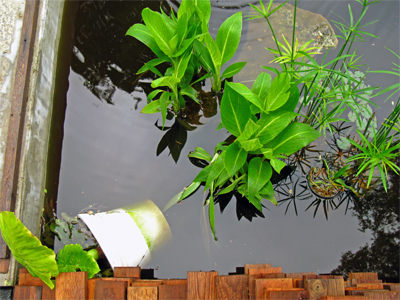Carol at May Dreams Gardens invites us to tell her what’s blooming in our gardens on the 15th of each month.
May 15, 2008
Austin has two summers. May marks our first early summer, when temperatures are in the low 80s to mid 90s and the humidity is off the chart. This is our old southern summer. As the meadow flowers go to seed, the sweet scents of four o’clocks, Confederate jasmine, crinum lilies, and magnolia hang heavily on the air. The humidity is oppressive but it typically means rain (often from violent thunderstorms). Generally May is wonderfully green. (The second summer is our southwestern summer which starts around the 4th of July. Then we expect long days of drought, temperatures in the 100s, water-rationing, and general misery. The color of second summer is brown.)
In my garden, May has the feel of winding down. I yank out the wildflowers, save seeds, and top dress and mulch all the plants I hope to keep through summer. This year, I think I’ll rename May “Pam/Digging” month. She’s given me so many passalongs that are in bloom right now, finally finding sunlight as I pull the exuberant growth of the wildflowers off them: white mistflower, purple coneflower, society garlic, and zexmenia. Pam has helped me extend the flowering season at Zanthan Gardens and May is no long just the month of green.
New for May
Acanthus mollis

This very tropical-looking plant with the imposing flower stalk is one of my favorites. Apparently it can’t be killed. People from the Pacific northwest frequently write to me to ask how to get rid of it. In Austin, it dies down when temperatures hit 92F–so it’s not a problem. In fact, its habit leaves a disappointing hole in the border during the summer.
Magnolia grandiflora ‘Little Gem’

Bruised, battered, and blooming–my ‘Little Gem’ magnolia is the perfect emblem for this May’s bloom day after last night’s very destructive storm.
Rudbeckia hirta, Black-eyed Susan

I planted the annual black-eyed Susans the first summer I lived here and I’ve never been without them since. They self-sow, coming up the same time as the bluebonnets and the larkspur but not flowering until those spring wildflowers have died down. I don’t really love it but I’m always glad to see it because for years it was the only thing blooming in my garden at this time of year. Last year I bought the perennial Rudbeckia fulgida; they’re just coming up now.
Echinacea purpurea, purple coneflower

One of the passalongs from Pam/Digging. This is the first time I’ve ever grown purple coneflower and these are the first flowers that bloomed.
And also new for May…
- Borago officianalis
- Cosmos sulphureus
- Dolichos lablab
- Hibiscus syriacus
- Malvaviscus arboreus Turks cap
- Nigella damascena ‘Mulberry Rose’ (3 miniscule flowers the size of a dime)
- Papaver somniferum “Dorothy” selection
- Plumbago auriculata
- rose ‘New Dawn’ (back, north border)
- Ruellia
- summer squash
- white mistflower
- Zexmenia
Between GBBDs
Several flower bloomed and faded in my garden between GBBDs and so didn’t show up in the inventory for either April or May.
- bearded iris ‘Champagne Elegance’
- bearded iris ‘Silverado’
- Nigella damascena ‘Mulberry Rose’ (3 miniscule flowers the size of a dime)
- rose ‘Mermaid’
- Tulbaghia violacea (society garlic)
- Zephyranthes grandiflora (some bloomed yesterday, some will bloom tomorrow, but none are blooming today. Killjoys.)
Complete List for May
The garden is not as flowery as this list might make you believe. About half these flowers are going to seed and about to get composted.
- Acanthus mollis
- Borago officianalis
- Centaurea cyanus Black Magic’
- Commelinantia anomala (a couple that resist my stamping them down)
- Consolida ambigua (a few in the shade)
- Cosmos sulphureus
- Dolichos lablab
- Dianthus chinensis (reblooming now that the wildflowers have been cleared off)
- Duranta erecta
- Echinacea purpurea
- Engelmannia peristenia/pinnatifida
- Erythrina herbacea (coral bean)
- Eschscholzia californica ‘Mikado’
- Eupatorium wrightii
- Hesperaloe parviflora
- Hibiscus syriacus
- Lantana montevidensis (a few tiny flowers)
- Lantana x hybrida ‘New Gold’
- Lathyrus odoratus ‘Perfume Delight’
- Lavandula heterophylla ‘Goodwin Creek’ (a few tiny flowers)
- Lupinus texensis (mostly going to seed; first plant now flowering since 12/15)
- Magnolia grandiflora ‘Little Gem’
- Malvaviscus arboreus
- Mirabilis jalapa
- Nandina domestica
- Nerium oleander ‘Turner’s Shari D.’
- Nigella damascena ‘Persian Jewels’ mix
- Oenothera speciosa
- Oxalis crassipis (hot pink, full bloom)
- Oxalis triangularis (only purple, not white)
- Papaver somniferum “Dorothy” selection
- Polanisia dodecandra
- Phlomis lanata
- Plumbago auriculata
- Retama
- rose ‘Blush Noisette (full bloom)
- rose ‘Ducher’ (waning)
- rose ‘New Dawn’
- rose ‘Red Cascade’ (two small flowers)
- rose ‘Souvenir de la Malmaison’ (one flower opened today)
- Rudbeckia hirta
- Ruellia
- Sedum album
- Setcresea (both purple and green)
- Trachelospermum jasminoides (starting to fade)
- Verbena canadensis (lavender wilding)
- Viola cornuta ‘Sorbet Coconut Duet’
- Zexmenia hispida
In addition to the flowers, the following fruits or vegetables are also blooming: strawberries, tomatoes, peppers, and squash.



























